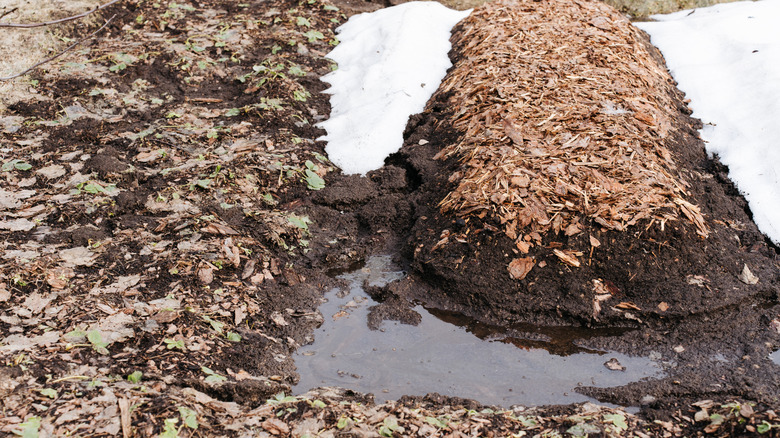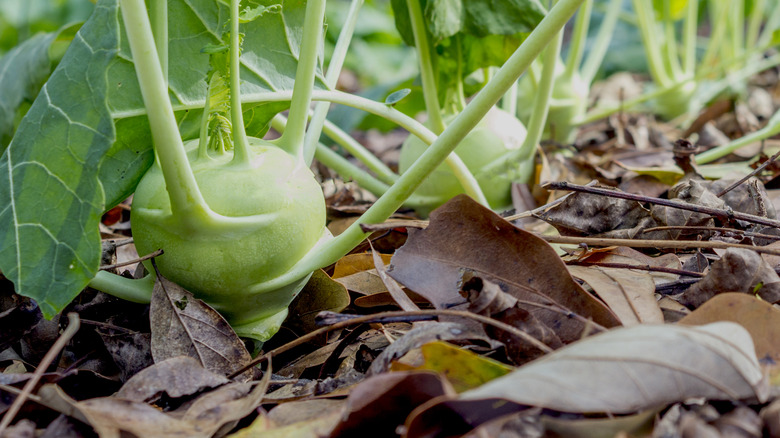Winter Mulch Mistakes That Could Result In Unwanted Pests
Don't you just love that feeling of tucking your plants in for winter by placing a nice layer of mulch around them? It benefits your plants by suppressing disease, protecting bare soil from erosion, and providing them with insulating warmth. Unfortunately, mulch application at any time can risk attracting pests, and it's especially risky when you're making mistakes. Both invertebrate (insects, worms, snails, slugs) and vertebrate (voles, mice, snakes) intruders can be attracted to your mulch.
Common mistakes that attract pests include using wet mulch, layering on too much and creating mulch "volcanoes" around trees and plants, using the wrong kind, and placing mulch too close to your home and other structures. While this ground covering makes a great hiding place for both pests and beneficial species, you can avoid mistakes — and limit the number of destructive pests hiding in your mulch — while still reaping its benefits.
Overwatering mulch and attracting moisture pests
The good news is that the vast majority of insects found in mulch are beneficial or at least harmless. But if you have bugs in your compost, it's likely because the mulch holds moisture. Termites are especially attracted to moisture, and while mulch will always hold some dampness, the crucial mulch mistake contributing to your pest problem is using wet mulch.
Critters like termites are known as moisture pests, which are attracted to damp mulch. Other moisture pests include fungus gnats that chew roots, earwigs, which consume decaying debris and plant parts, and centipedes, which can deliver a slightly toxic bite at the pain level of a wasp sting. It's when these moisture pests make their way into your house that they become especially problematic. Ensuring your mulch is as dry as possible even in the face of winter snow can help you win the battle against moisture pests in your compost.
Piling on too much mulch and creating 'volcanoes'
You may be tempted to pile on mulch to ensure winter insulation, but less is more. A too-thick layer of mulch is a mistake that attracts insects, along with larger pests — voles, mice, and snakes. The presence of mulch that is too heavily applied can attract these pests, especially when applied in what has become known as the "volcano" form. This occurs when a large amount of mulch is placed around a tree or plant in a volcano shape. Instead, mulch should lay flat, and virtually no mulch should touch the tree trunk.
Rodents may gnaw on a volcano-surrounded tree. Attracted by deep mulch layers, both mice and voles pursue shelter by burrowing into those layers and eating the nutrient-rich tree layer under the bark. Insect presence in the volcano may promote disease. Mulch volcanoes can damage and even kill trees, and in the process, pests like native borers may attack trees in a vulnerable condition.
To protect your tree in winter, put down no more than a 2 to 3-inch layer of mulch. Termites, for example, will be deterred by mulch layers that are less that 4 inches thick. For both voles and mice, using a thin layer will make mulch less appealing as a cozy hangout. The thinner the mulch pile, the less protected pests will feel, making the mulch less inviting. And just say no to mulch volcanoes.
Using a type of mulch that attracts pests
The organic material in mulch can provide winter nourishment for some pests. For example, slugs and snails are both attracted to mulch made of leaves. If you are using leaves, putting mulch in your garden could invite jumping worms, as well. Keeping leaves to a minimum and the mulch layer to just an inch will help deter these pests. You can use leaves if you compost them first; slugs eat decomposing material, so if it's already decomposed, they're not interested. Try a coarse, woody option, which slugs and snails dislike, and avoid using grass clippings in mulch. Among organic mulches, cedar mulch, which contains the compound thujone, is the best type of mulch to use if you want to keep bugs away, but it can also deter beneficial insects. Arborist wood chips are another option, as they contain chemicals toxic to insect pests.
Although organic mulches are beneficial to the plants they protect, extreme cases of pest invasion may signal a need to switch to an inorganic mulch. This is especially true in the winter, when pests will be desperately seeking nourishment and won't find it elsewhere. Gravel is the landscaping material that works as a barrier around your home to keep rodents out, and it can also be used as an inorganic mulch if you have a serious problem with these pests.
Putting mulch in the wrong places
Finally, we come to mistakes in mulch placement. Your garden may look bare in the winter, leading you to add mulch for added color and to fill in dead spots, especially around your home. But mulch should be piled neither directly against trees nor against homes and other structures. Termites are attracted to woody or moist mulch and could easily make their way into your house if it's nearby. Therefore, you shouldn't spread mulch right next to your house if you don't want unwelcome guests. Plaster beetles, like termites, are a problem near homes as they infest walls that have just been plastered.
A few bonus tips can help prevent mulch mistakes. Disturbing the mulch regularly may keep pests in check, as they can't easily get established with disruptions in their environment. A great way to disturb your winter mulch is by raking it, which has the added benefit of exposing pests to winter elements that may kill them. As you consider your yard in winter — the unexpected time of year that you'll want to refresh the mulch in your garden — be sure you are monitoring your mulch for unwanted invaders and avoiding common mulch mistakes.




